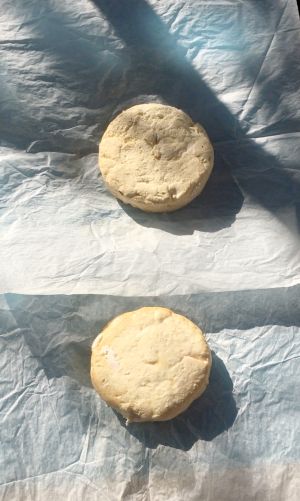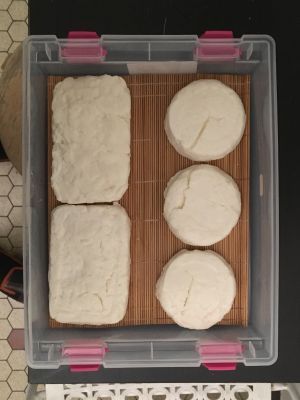Cheese production archives: Difference between revisions
No edit summary |
|||
| Line 91: | Line 91: | ||
==October-November 2020 | Sint Gertruuid cheeses in Maastricht== | ==October-November 2020 | Sint Gertruuid cheeses in Maastricht== | ||
<b>When joining the Jan Van Eyck Academie and its Food Lab in Maastricht; our initiative for the first months of the residency was to learn, with the help of industrial ferments ([https://en.wikipedia.org/wiki/Danisco Danisco]), the behaving of the 5 basic microorganisms used in cheese production: | |||
# Starter cultures including lactic ferments (<i>Lactococcus</i>, <i>Streptococcus thermophilus</i>, etc.) | |||
# <i>Geotrichum candidum</i> | |||
# <i>Penicillium candidum</i> (<i>camemberti</i> or <i>roqueforti</i>) | |||
# <i>Brevibacterium linens</i> | |||
</b> | |||
===Limburger cheeses=== | |||
[[File:.jpg|thumb|Thumbnailed image|]] | |||
{| class="wikitable" | |||
|- | |||
! Milk origin !! Milk processing and curdling !! Culture input !! Molding !! Ripening time and process | |||
|- | |||
| Cow full milk, unpasteurised, provided by Hoeve de Koeberg, an organic farm based next to Sint Geertruid village, in the Limburg region. || Liquid animal rennet<ref name="rennet" /> in heated milk (30-35°C). 1h curdling before cutting the curds in 2cm cubes. Let sit 30min at same temperature. || Lactic ferments <ref class=""></ref> and . || Medium plastic molds from <i>faisselle</i> yogurt and cheesecloth. Softly pressed with a glass of water for a few hours, on both sides. || - Dry salting on both sides after demolding. <br/>- Turned daily the first week. <br/>- 10 days of ripening on a wooden board, in an aerated cheese box with a piece of beech timber found in the forest. | |||
|} | |||
Text. | |||
<gallery mode="traditional"> | |||
File:.jpg| | |||
File:.jpg| | |||
File:.jpg| | |||
</gallery> | |||
<hr> | |||
===name=== | ===name=== | ||
[[File:.jpg|thumb|Thumbnailed image|]] | [[File:.jpg|thumb|Thumbnailed image|]] | ||
{| class="wikitable" | {| class="wikitable" | ||
|- | |- | ||
! Milk origin !! Milk processing and curdling !! | ! Milk origin !! Milk processing and curdling !! Culture input !! Molding !! Ripening time and process | ||
|- | |- | ||
| Cow full milk, unpasteurised, provided by Farm of Ondet corner, in the mountains of Mont-Dore, France. || Powdered animal rennet<ref name="rennet" /> in heated milk (30-35°C), 24h curdling. || No lactic ferments nor starter culture. || Medium plastic molds from <i>faisselle</i> yogurt and cheesecloth. Softly pressed with a glass of water for a few hours, on both sides. || - Dry salting on both sides after demolding. <br/>- Turned daily the first week. <br/>- 10 days of ripening on a wooden board, in an aerated cheese box with a piece of beech timber found in the forest. | | Cow full milk, unpasteurised, provided by Farm of Ondet corner, in the mountains of Mont-Dore, France. || Powdered animal rennet<ref name="rennet" /> in heated milk (30-35°C), 24h curdling. || No lactic ferments nor starter culture. || Medium plastic molds from <i>faisselle</i> yogurt and cheesecloth. Softly pressed with a glass of water for a few hours, on both sides. || - Dry salting on both sides after demolding. <br/>- Turned daily the first week. <br/>- 10 days of ripening on a wooden board, in an aerated cheese box with a piece of beech timber found in the forest. | ||
Revision as of 11:15, 22 January 2021
September 2019 | Normandie smoked cheese in Paris
Rygeost cheeses
| Milk origin | Milk processing and curdling | Starter | Molding | Ripening time and process |
|---|---|---|---|---|
| Normandie full cow milk, unpasteurized. | Powdered animal rennet[1] in heated milk (30-35°C), 24h curdling. | No lactic ferments nor starter culture. | Homemade molds from drilled plastic containers where the cheeses spent a few days without being pressed. | - Turned daily the first week. - 2 days outside in an aerated box before dry salting on both faces. - 4 days in fridge before smoking for 1 hour with hay. - Kept in fridge 1 more week before serving (2 months for extra batch). |
This cheese recipe was inspired by a Danish smoked cheese called Rygeost. It is crucial to let the cheese rest at least one week after smoking, so that the burnt taste does not take over on the freshness of the soft cheese taste. The cheese should not be over-ripen, but it can be kept in the fridge for 2 weeks as the smoke prevents mold to develop on its rind. 2 batches of this cheese were made in Paris before to be served in Amsterdam on the 4th of October for a performance dinner called The Soft Protest, re-chewing & Digest. A third batch was kept unsmoked and ripen for 2 month.
- Error creating thumbnail: File missing
- Error creating thumbnail: File missing
- Error creating thumbnail: File missing
- Error creating thumbnail: File missing
February 2020 | Vexin cheeses in Paris
Soft blue cheese attempt
| Milk origin | Milk processing and curdling | Starter | Molding | Ripening time and process |
|---|---|---|---|---|
| Vexin full cow milk, unpasteurized. (Sourced from Laiterie de la Chapelle, Paris.) | Powdered animal rennetCite error: Closing </ref> missing for <ref> tag and . |
Medium plastic molds from faisselle yogurt and cheesecloth. Softly pressed with a glass of water for a few hours, on both sides. | - Dry salting on both sides after demolding. - Turned daily the first week. - 10 days of ripening on a wooden board, in an aerated cheese box with a piece of beech timber found in the forest. |
Text.
- .jpg
- .jpg
- .jpg
name
| Milk origin | Milk processing and curdling | Culture input | Molding | Ripening time and process |
|---|---|---|---|---|
| Cow full milk, unpasteurised, provided by Farm of Ondet corner, in the mountains of Mont-Dore, France. | Powdered animal rennet[1] in heated milk (30-35°C), 24h curdling. | No lactic ferments nor starter culture. | Medium plastic molds from faisselle yogurt and cheesecloth. Softly pressed with a glass of water for a few hours, on both sides. | - Dry salting on both sides after demolding. - Turned daily the first week. - 10 days of ripening on a wooden board, in an aerated cheese box with a piece of beech timber found in the forest. |
Text.
- .jpg
- .jpg
- .jpg

